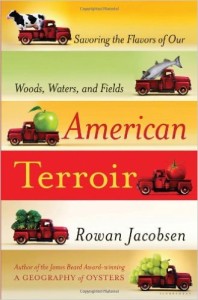 Where does your food come from? What elements of the landscape made their way into the flavour of your favourite maple syrup, or your apples? If you haven’t been asking yourself questions along these lines already, Rowan Jacobsen’s American Terroir will make you eager to start.
Where does your food come from? What elements of the landscape made their way into the flavour of your favourite maple syrup, or your apples? If you haven’t been asking yourself questions along these lines already, Rowan Jacobsen’s American Terroir will make you eager to start.
You could start with breakfast. Jacobsen does. The book is structured around what he calls “the order of foods you might eat in a day — a very good day.” He begins by taking us out to a few New England sugarbushes – stands of maple trees tapped for sap – and shows how weather, soil composition and bacterial action shape the specific flavour of each barrel of syrup. Visiting the tasting room of one artisan sugarmaker, Jacobsen samples a few special batches. In telling us of the experience, he reveals one of the skills that make this book a delight: the author’s uncommon capacity to successfully evoke how things taste with words. Jacobsen’s conversational voice and his wit make American Terroir an easy read; but writing about food (to paraphrase Frank Zappa) is kind of like dancing about architecture, and if so, Jacobsen dances a good building.
From maple syrup he moves on to a few varietal coffee beans sold at auction for over $100.00 a pound… and the market pressures that have driven less flavourful beans to dominate the industry.
Then it’s a quick history of how Prohibition and market research combined to reduce the number of varieties of apple grown in America, killing the market for tart cider apples (in the one instance) and (in the other) focusing purchasing power onto apples grown for proven sales based on colour… regardless of flavour. The decline is a kind of shock that becomes familiar in American Terroir: “From more than fourteen thousand varieties of apple listed by the U.S. Department of Agriculture in 1905,” he tells us, “we are down to less than one hundred.” But as before, Jacobsen offers us hope in a look at the little guy. In the rocky heights of Washington’s Yakima Valley, he leads us to family operation growing apples which — if his word can be trusted- beat anything most of us have ever yet tasted. Can we trust him? Well, based on his descriptions, I’m willing to make the sacrifice — I’ll test them.
So he’s sold me, anyway. I’ll go further, and say he’s inspired me. And make no mistake, Jacobsen aims to inspire. American Terroir is a passionate, joyous, mouth-watering wake-up call to taste buds all over the country. Sources and resources, recipes and contact information, season the end of every chapter. Indirectly, Jacobsen has set me to tracking down rumours of a man in my county who supposedly grows a hundred different varieties of apple. Hmm. Cider apples could be growing in my orchard soon…
Then again, they may not grow well here. This part of California is easy country for apples. And one recurring theme in this book is that the best land doesn’t always produce the best flavour. Hardship builds character, it seems, even in the world of food and drink. And this is the book’s subversive triumph. Soon you’ll begin to wonder what crops would fight their way to deliciousness on your worst patch of garden. And your mouth will begin to water for fresh levels of richness or subtlety in foods you thought you knew, flavours you have never yet experienced.
Wines, potatoes, oysters, avocadoes, chocolate and more: Rowan Jacobsen paints a vivid, witty picture of just how much we have lost from our cultural palate, and the people who are trying to bring it back to us. He stirs up a fresh sauce of anecdote, chemistry, botany, history and tradition. It’s a blue-ribbon recipe.
(Bloomsbury, 2010)
